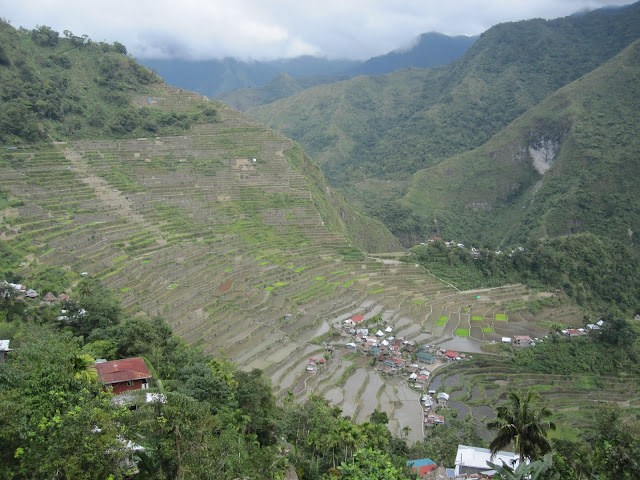Batad Rice Terraces and a Hip Mountain Town
For possibly thousands of years (the dates are debated) rice farmers in the Cordilleras of Northern Luzon have been constructing and maintaining series of magnificent rice terraces. The terraces are literally cut into the sides of hills or small mountains. Each individual level, like most rice fields, is small; many are no bigger than a typical hotel room. Some terraces are quite small, while others extend for dozens of levels up hills.
The most well known of these terraces are near the town of Banaue. The terraces at Batad have been classified as a UNESCO World Heritage Site, and for good reason. I was fortunate enough to travel from Banaue to Batad and hike along the terraces. I went with a group of a dozen tourists in a hired jeepney for the day. A local guide took us from the drop-off point down to the terraces and to a nearby waterfall.
 |
| Our jeepney and guide (left) |
 |
| View from the road - gotta ride on top to get the view! |
 |
| The Batad rice terraces |
 |
| Walking along the terraces |
 |
| Well I guess I will put one picture of me up as well |
 |
| A huge waterfall near Batad |
We then had lunch in the town of Batad and made our way back to Banaue. On the return I chose to ride on top of the jeepney, which is bumpy but rewarded me with great views down into the valleys. The road cut through the hills and often I could look straight down off the road several hundred meters. If you are afraid of heights, I wouldn't recommend it!
After two nights in Banaue I decided to visit Sagada. Sagada is further off the transport map in the hills of the Cordilleras. Despite its remote location, it has become a haven for backpackers. Some go there for only a night or two, others apparently end up staying for weeks. I enjoyed it for sure, but wouldn't recommend more than a few days unless an isolated mountain town is your thing. I'd much rather be on the beach!
It turned out that three other hikers from the rice terraces were also going to Sagada on the same jeepney (it's a small backpacker community up there). We stuck together and had lunch the day we arrived. After lunch we took a short hike to see hanging coffins; some local communities practice a strange and unique burial ritual - they hang (or support with metal rods) coffins in the nearby cliffs. Hikers can get within a few feet of the coffins, although there aren't more than 10 or so in the easy to access areas.
 |
| The famous hanging coffins |
 |
| I wonder what the chairs symbolize? |
 |
| A normal graveyard in Sagada - for the Catholics, not nearly as cool as the pagan coffins |
That afternoon we also hiked to a lookout point with great views of the town and rice terraces below. After Batad I was a bit spoiled, but the terraces near Sagada are still nice. That night we met up at a reggae bar, which happened to be connected to a Korean restaurant next door (wtf? Who could have thought up that combination?).
The following morning the three of us (one was sick so she stayed at the hotel) went on a hike into a cave only 15 minutes' drive from the town. In one section we got to swim in the cold water. There was a longer option, but an hour plus seemed like long enough for me and the others (and our wallets - you have to hire a guide).
I had been debating staying longer in Sagada, but it seemed like we had accomplished most of what there is to see there, so I got the last bus (1 pm) to Baguio. Yes, 1 pm was the last bus - things close early in the provincial towns! Not 1 pm, but by sundown (around 6 pm) many stores call it a night. So on my vacation I found myself going to bed by 9 or 10 and waking up at dawn! Well there wasn't much else to do at night, so better to be productive I guess.




Comments